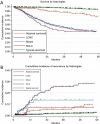The European Society of Thoracic Surgeons (ESTS) lung neuroendocrine tumors (NETs) database
- PMID: 30510790
- PMCID: PMC6230831
- DOI: 10.21037/jtd.2018.04.104
The European Society of Thoracic Surgeons (ESTS) lung neuroendocrine tumors (NETs) database
Abstract
Histological characteristics and clinical behaviour define lung neuroendocrine tumors (NETs), which are classified into four groups: typical (TC) and atypical carcinoids (AC), large-cell neuroendocrine carcinomas (LCNCs) and small-cell lung cancers (SCLCs). Historically, outcome and treatment of these rare neoplasms have been based on small, usually mono-institutional clinical series. Furthermore, their rarity makes quite impossible to design randomised clinical trial to compare different treatments especially in unusual clinical presentations. In 2012, the European Society of Thoracic Surgeons (ESTS) launched a new working-group, specifically dedicated to lung NETs, with the aim to develop modern knowledge on biology and behaviour of these tumors, and to disseminate it within the scientific community. A dedicated retrospective database was at first developed and sent to all the ESTS centres interested to this project. More than 2,000 operated NETs cases have been rapidly collected, and they represented the clinical substrate of several published scientific studies. The retrospective data collection intrinsic limitations in term of patients' selection and treatment, along with the problem of possible missing data, were the reasons why the ESTS NETs working-group decided in 2015 to design and promote a new prospective database, employing the official ESTS platform. The aim of this review paper is to report the ESTS Lung NETs working-group history and to explain the architecture and use of the lung NETs databases.
Keywords: Lung; neuroendocrine tumors (NETs); outcome; prospective database; retrospective database.
Conflict of interest statement
Conflicts of Interest: The authors have no conflicts of interest to declare.
Figures



References
Publication types
Grants and funding
LinkOut - more resources
Full Text Sources
